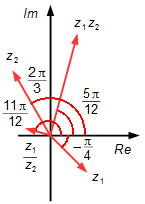Exercício Resolvido de Números Complexos
publicidade
c) \( z_{1}=1-i \) , \( z_{2}=-1+i\sqrt{3} \)
O módulo é dado por
\[ \bbox[#99CCFF,10px]
{|z|=\sqrt{x^{2}+y^{2}}}
\]
- Para z1
\[
\begin{gathered}
|z_{1}|=\sqrt{1^{2}+(-1)^{2}}\\
|z_{1}|=\sqrt{1+1}\\
|z_{1}|=\sqrt{2}
\end{gathered}
\]
- Para z2
\[
\begin{gathered}
|z_{2}|=\sqrt{(-1)^{2}+\left(\sqrt{3}\right)^{2}\;}\\
|z_{2}|=\sqrt{1+3\;}\\
|z_{2}|=\sqrt{4\;}\\
|z_{2}|=2
\end{gathered}
\]
O argumento é dado por
\[ \bbox[#99CCFF,10px]
{\theta=\operatorname{arg}(z)=\operatorname{arctg}\left(\frac{y}{x}\right)}
\]
- Para z1
\[
\begin{gathered}
\theta_{1}=\operatorname{arctg}\left(\frac{-1}{1}\right)\\
\theta_{1}=\operatorname{arctg}(-1)\\
\theta_{1}=-{\frac{\pi}{4}}
\end{gathered}
\]
- Para z2
\[
\begin{gathered}
\theta_{2}=\operatorname{arctg}\left(\frac{\sqrt{3}}{-1}\right)\\
\theta_{2}=\operatorname{arctg}\left(-{\sqrt{3}}\right)\\
\theta_{2}=\frac{2\pi }{3}
\end{gathered}
\]
Escrevendo z na forma polar
\[ \bbox[#99CCFF,10px]
{z=r(\cos \theta +i\operatorname{sen}\theta )\ \ ,\ r=|z|}
\]
\[
z_{1}=\sqrt{2}\;\left[\cos \left(-{\frac{\pi}{4}}\right)+i\operatorname{sen}\left(-{\frac{\pi }{4}}\right)\right]
\]
Como cosseno é uma função par
\( \cos \left(-{\frac{\pi }{4}}\right)=\cos \left(\frac{\pi }{4}\right) \),
e como seno é uma função ímpar
\( \operatorname{sen}\left(-{\frac{\pi}{4}}\right)=-\operatorname{sen}\left(\frac{\pi }{4}\right) \)
\[ \bbox[#FFCCCC,10px]
{z_{1}=\sqrt{2}\;\left(\cos \frac{\pi }{4}-i\operatorname{sen}\frac{\pi}{4}\right)}
\]
\[ \bbox[#FFCCCC,10px]
{z_{2}=2\;\left(\cos \frac{2\pi }{3}+i\operatorname{sen}\frac{2\pi}{3}\right)}
\]
A multicação de números complexos na forma polar é dada por
\[ \bbox[#99CCFF,10px]
{z_{1}z_{2}=r_{1}r_{2}[\cos (\theta _{1}+\theta_{2})+i\operatorname{sen}(\theta_{1}+\theta _{2})]}
\]
\[
\begin{gathered}
z_{1}z_{2}=\sqrt{2}.2.\left[\cos \left(-{\frac{\pi}{4}}+\frac{2\pi}{3}\right)+i\operatorname{sen}\left(-{\frac{\pi}{4}}+\frac{2\pi }{3}\right)\right]\\
z_{1}z_{2}=2\sqrt{2}.\left[\cos\left(\frac{-3\pi +8\pi}{12}\right)+i\operatorname{sen}\left(\frac{-3\pi +8\pi}{12}\right)\right]
\end{gathered}
\]
\[ \bbox[#FFCCCC,10px]
{z_{1}z_{2}=2\sqrt{2}.\left(\cos \frac{5\pi}{12}+i\operatorname{sen}\frac{5\pi}{12}\right)}
\]
A divisão de números complexos na forma polar é dada por
\[ \bbox[#99CCFF,10px]
{\frac{z_{1}}{z_{2}}=\frac{r_{1}}{r_{2}}[\cos (\theta _{1}-\theta_{2})+i\operatorname{sen}(\theta _{1}-\theta _{2})]}
\]
\[
\begin{gathered}
\frac{z_{1}}{z_{2}}=\frac{\sqrt{2}}{2}.\left[\cos\left(-{\frac{\pi }{4}}-\frac{2\pi}{3}\right)+i\operatorname{sen}\left(-{\frac{\pi }{4}}-\frac{2\pi}{3}\right)\right]\\
\frac{z_{1}}{z_{2}}=\frac{\sqrt{2}}{2}.\;\left[\cos\left(\frac{-3\pi -8\pi}{12}\right)+i\operatorname{sen}\left(\frac{-3\pi -8\pi}{12}\right)\right]\\
\frac{z_{1}}{z_{2}}=\frac{\sqrt{2}}{2}.\;\left[\cos\left(\frac{-11\pi }{12}\right)+i\operatorname{sen}\left(\frac{-11\pi}{12}\right)\right]
\end{gathered}
\]
\[ \bbox[#FFCCCC,10px]
{\frac{z_{1}}{z_{2}}=\frac{\sqrt{2}}{2}.\;\left(\cos \frac{11\pi}{12}-i\operatorname{sen}\frac{11\pi }{12}\right)}
\]

publicidade

Fisicaexe - Exercícios Resolvidos de Física de Elcio Brandani Mondadori está licenciado com uma Licença Creative Commons - Atribuição-NãoComercial-Compartilha Igual 4.0 Internacional .